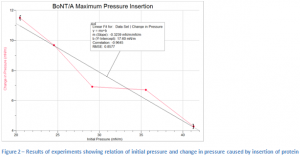Eric R. Draper and Professor David Busath, Department of Biophysics
Botulinum neurotoxin is a neurotoxic protein that is made by the bacterium Clostridium Botulinum. It is one of the most deadly toxins in the world and is very commonly used in minute doses for medicinal purposes. It is therefore very important and beneficial to understand the mechanism by which the protein attaches to and injects its contents across cell membranes. In the protein there is a heavy chain and a light chain. These two chains work together in attaching to cells and injecting the light chain across the cell membrane. Through work with a Langmuir-Blodgett trough I have created lipid monolayers and have measured the effect on surface pressure of the monolayer as the toxin attaches itself to the lipid membrane.
These experiments were run using a Langmuir-Blodgett (LB) trough. The Langmuir-Blodgett trough is used to detect lateral surface pressure changes in lipid monolayers. Parts include a trough, a barrier that sits across the edges of the trough and divides it into two areas, and a Wilhelmy Rod on a balance hook connected to a pressure sensor. The Wilhelmy Rod hangs down into one of the sides of the trough. Typically, a monolayer is placed over a pre-chosen buffer and protein is injected into the subphase. When the barrier is used it serves as a divider so the lipid can only stay on one side of the barrier. The injection can either be directly through the lipid or, if a barrier is used, underneath the barrier. Shortly after injection, the protein may interact with the monolayer and cause a measurable pressure change. This measure change is graphed by a computer connected to the LB trough with time on the x axis and pressure on the y axis.
The results are graphed by the computer with pressure on the y axis and time on the x axis (Figure 1). These graphs show when the BONT inserts (it inserts at the dramatic increase in pressure).

These graphs also make it possible to tell when the BONT has not inserted into the monolayer and how much the monolayer pressure is affected by the BONT when it does insert.
The results of the experiments that were run showed that as initial monolayer pressure increases change in pressure caused by the protein decreases (Figure 2). This graph is a result of 23 experiments run.

Figure 2 shows that there is a linear correlation between the initial pressure and change in pressure. This is significant because any substance that can cause a localized change in cellular membrane pressures could also potentially inhibit the activity of protein toxins that require insertion across a membrane protein. As initial monolayer is set to above 40 mN/m the BONT heavy chain becomes ineffective at increasing the monolayer pressure, therefore leading to the conclusion that it is unable to insert. At 42 mN/m the BONT heavy chain has no significant effect on the monolayer pressure (it changes it by less than 1 mN/m). At 30 mN/m, which is standard cell pressure, the BONT heavy chain changes monolayer pressure by an average of seven to eight mN/m.
This research will be continued in the upcoming semesters. My goal is to determine whether the increase in monolayer pressure is statistically significant, whether it is affected by factors such as temperature and pH, and whether the light chain and non-binding proteins would NOT cause pressure increase. Our source of the recombinant botulinum toxin is no longer willing to provide us with the toxin, so I will have to synthesize a recombinant form of the neurotoxin which is structurally similar to the original toxin but is not lethal. There are several known ways of producing recombinant, inactive forms of botulinum neurotoxin that attach to cell membranes in the same way as the original neurotoxin.
This laboratory experience was very enlightening and I have learned far more about protein-lipid interactions than I could ever have imagined. I look forward to continuing my research under Dr. Busath and in publishing the results we have thus far found.
